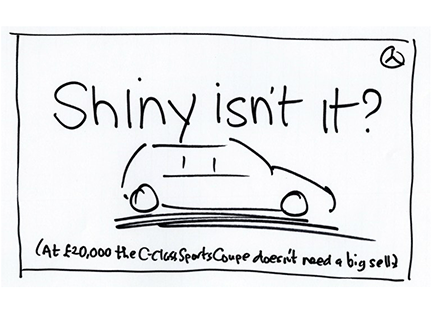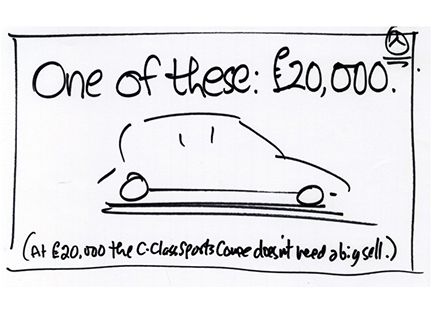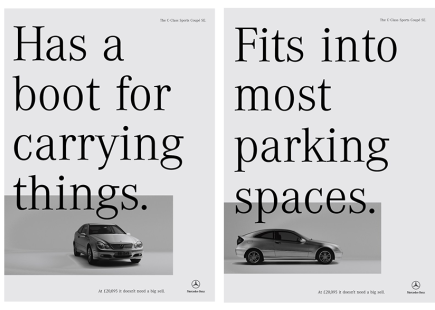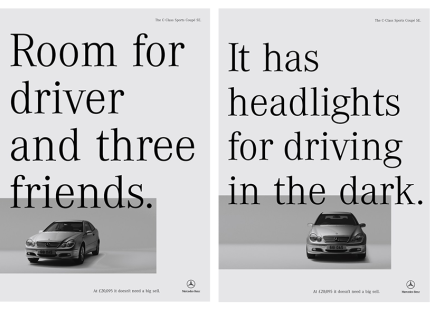Straight-talking ads without the cliches from Mercedes-Benz

The Background
Few sectors encapsulate the golden era of advertising as succinctly as car ads.
Whether it's Bill Bernbach's iconic work for VW or David Ogilvy's campaign for Rolls-Royce, this was art and copy that shifted the direction of the craft for years to come.
What was the thread that ran through these ads to make them resonate—and sell the product—so successfully? Was it the truth that they spoke through the copy? The wit and urbane nature of the headlines? Keeping the product at the heart of the matter?
It's all of these things. And it's a recipe that we, arguably, don't see enough of today.
But, back at the turn of the century, the creative team at London's CDD agency channelled that energy in a beautiful campaign for Mercedes-Benz.
The Big Idea
In October 2000, Mercedes-Benz launched a new compact hatchback, called the C-Class Sport Coupé. But sales were lower than expected. With a stockpile of cars sitting unsold in an airfield, it was agreed that the prices should be reduced.
To get the word out about the discounted hatchbacks, the manufacturer approached fledgling London agency, CDD. Creative directors Dave Dye and Sean Doyle picked up the brief and got to work.
The problem was clear: how do you advertise a discount on a premium product, without eroding the product's exclusivity?
Dye and Doyle took the perspective that, rather than highlighting the reduced price, the ad should show the deal to be so enticing for such a quality product that it's a no-brainer for the customer.
But having a great idea is one thing. Turning it into an effective execution is another.


What They Did
The initial sketches for the ad (which you can see in this excellent piece by Dave Dye himself) pushed the idea in a straightforward, clean line: "At £20,000 it doesn't need a big sell."
The concept quickly evolved into something that drew on the humour and humanity of those golden age ads.
By adding in short, tongue-in-cheek headlines such as 'Goes down streets' and 'Shiny, isn't it?', the campaign came to life.
Teamed up with some understated photography from Ben Stockley and stunning graphic positioning by Dye, the campaign had a strut and sophistication that echoed VW's 'Lemon', while making a path all of its own.
CDD got a lucky break when the client pulled some press ads for another model, giving them space to run the ads.
The initial feedback was not great.
Mercedes-Benz dealers and sales employees questioned why the features on their latest model were being downplayed. Why was a premium product being aped in this way? They questioned whether the agency knew what they were doing.
A meeting was called with the senior client team. Sales had almost doubled since the ad had run.
Despite the negative response from inside the company, it looked like the ads had done the job of selling the product. And then some.


The Review
The fact that these ads increased sales is perhaps the most worthy praise to be cast upon them. Should that be the only measure of an ad's success? Perhaps but that's an argument for another time.
Aside from the fact that they got the job done, there is plenty to applaud here.
The language never speaks down to the customer.
Instead, it acts as a friendly, familiar voice reassuring the customer that this purchase is the right thing to do. And it does that with humour, and with brevity.
It shows how the complicated art of simplicity is vital in making an ad that doesn't bore the reader to tears.
Most of all, it elevates the product without resorting to aspirational clichés or hyperbole.
In Hindsight
When it comes to automotive ads, they seem to either get it completely right ('The Ultimate Driving Machine', 'Once Driven, Forever Smitten'), or badly wrong (you know the ones).
Almost 20 years after its inception, this campaign sits up there with the very best.
This work shows us that the ingredients of a great piece of creative work will always speak to the customer on their level.
It will educate without patronising and entertain without trying too hard.
And, ideally, it'll shift some stock as well.
Images: Hand-drawn sketches courtesy of Dave Dye
If you enjoyed this article, you can subscribe for free to our weekly email alert and receive a regular curation of the best creative campaigns by creatives themselves.
Published on:


